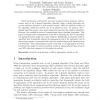Free Online Productivity Tools
i2Speak
i2Symbol
i2OCR
iTex2Img
iWeb2Print
iWeb2Shot
i2Type
iPdf2Split
iPdf2Merge
i2Bopomofo
i2Arabic
i2Style
i2Image
i2PDF
iLatex2Rtf
Sci2ools
EOR
2010
2010
Adaptive multicut aggregation for two-stage stochastic linear programs with recourse
Outer linearization methods for two-stage stochastic linear programs with recourse, such as the L-shaped algorithm, generally apply a single optimality cut on the nonlinear objective at each major iteration, while the multicut version of the algorithm allows for several cuts to be placed at once. In general, the Lshaped algorithm tends to have more major iterations than the multicut algorithm. However, the tradeoffs in terms of computational time is problem dependent. This paper investigates the computational trade-offs of adjusting the level of optimality cut aggregation from single cut to pure multicut. Specifically, an adaptive multicut algorithm that dynamically adjusts the aggregation level of the optimality cuts in the master program, is presented and tested on standard large scale instances from the literature. The computational results reveal that a cut aggregation level that is between the single cut and the multicut results in computational times of up to over 50% reduction ...
Algorithm | EOR 2010 | Major Iterations | Single Cut |
| Added | 10 Dec 2010 |
| Updated | 10 Dec 2010 |
| Type | Journal |
| Year | 2010 |
| Where | EOR |
| Authors | Svyatoslav Trukhanov, Lewis Ntaimo, Andrew Schaefer |
Comments (0)

